Enterprise mode is required to create scheduled deployments. PDQ deployment schedules are created in the Schedule window. A new Schedule window can be started from the Main Console window on a Package page.
This procedure includes the following parts:
•Part 1: Creating a New Schedule
•Part 2: Schedule Triggers and Settings
•Part 5: Schedule Deployment Settings
•Part 6: Completing the Schedule
VIDEO: Scheduling Deployments in PDQ Deploy
(https://support.pdq.com/hc/en-us/articles/115003911192)
Part 1: Creating a New Schedule
To schedule a deployment:
1.On the Main Console window, do one of the following: select the package or combination of packages and folders (Shift+click or Ctrl+click) you want to deploy.
•On the Toolbar, click New Schedule ![]() .
.
•Click File > New Schedule.
•Right-click the package (or one of the selected packages or folders) and select New Schedule.
•On the selected Package window, click Deploy > New Schedule.
•If multiple packages or folders are selected, on the Multiple Packages page, select Create new schedule with these packages.
A new blank Schedule window opens on the Triggers tab.

2.Type a name for the Schedule.
Use a name that makes sense for the new schedule.
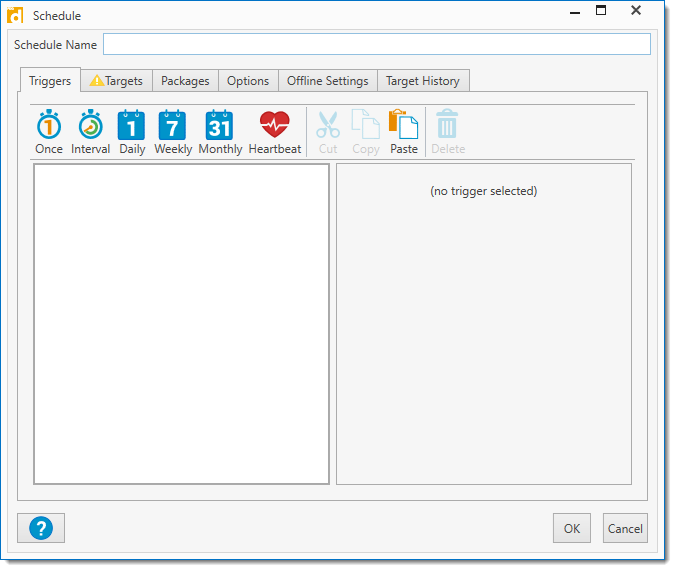
3.Continue to Part 2: Schedule Triggers and Settings.
Part 2: SCHEDULE TRIGGERS and Settings
To select a schedule trigger and configure schedule triggers:
1.On the Triggers tab, click a Schedule Trigger, then define the schedule settings.
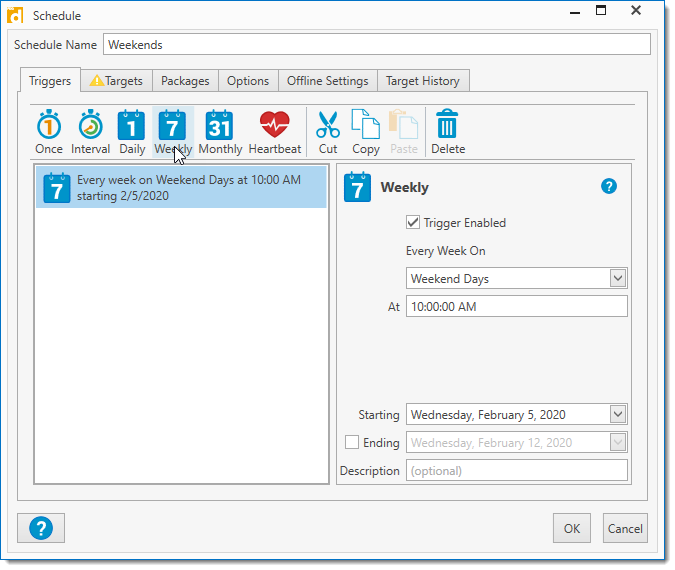
A schedule can include one or more triggers. Be careful of creating conflicts when setting frequencies or using multiple triggers. If triggers overlap, only one deployment will start. For example, having two triggers, one for every Monday at noon and one for every day at noon, will not start two deployments every Monday. See the table below for additional scheduling tips.
The following table provides information on the schedule triggers and settings available on the Triggers tab.
Schedule Triggers |
Icon |
Details |
|---|---|---|
|
Deploys the package once in the future. •Trigger Enabled: Enables the trigger for use (selected by default). •Trigger On: Date the trigger will run. •At: Time the trigger will run. •Description: (Optional) Description of the trigger.. |
|
|
Deploys (and repeats) at a set time interval. •Trigger Enabled: Enables the trigger for use (selected by default). •Every: The interval by day, hour, and minute. •Only run during the following time frame (Optional) Enables a set time frame. •Between: The start of the time frame. •And: The end of the time frame. •Starting: Date the trigger starts. •At: Time the first trigger starts. If the optional time frame is selected, the first trigger will occur at the start of the next time frame. •Ending: (Optional) Date the trigger ends. Leaving this unchecked will allow the trigger to run indefinitely. •At: (Optional) Time the trigger ends. •Description: (Optional) Description of the trigger. NOTE: Setting the 'Between' time later than the 'And' time will result in the trigger running overnight. |
|
|
Deploys every day at the same time. •Trigger Enabled: Enables the trigger for use (selected by default). •Every Day At: •Time the trigger will run. •Starting: Date the trigger starts. •Ending: (Optional) Date the trigger ends. Leaving this unchecked will allow the trigger to run indefinitely. •Description: (Optional) Description of the trigger. |
|
|
Deploys every week at the same time on selected days of the week. •Trigger Enabled: Enables the trigger for use (selected by default). •Every Week On: •Day (or days) that the trigger runs. •At: Time the trigger will run. •Starting: Date the trigger starts. •Ending: (Optional) Date the trigger ends. Leaving this unchecked will allow the trigger to run indefinitely. •Description: (Optional) Description of the trigger.. |
|
|
Deploys every month at the same time on selected days. •Trigger Enabled: Enables the trigger for use (selected by default). •Every Month •Day of the Month: The actual day (or days) of the month (for example, 1, 12, 23, etc.). If you select the 29th, 30th, or 31st of the month, the trigger won't run in months without those days. Select Last to always run the trigger on the last day of the month. Or •Day of the Week: The nth day of the month (for example, First Monday, Second Wednesday, Last, etc.). Different combinations of weeks and days require separate schedules (for example, the 1st Monday and the 2nd Friday). Selecting the 5th week won't run the trigger in a month without a fifth week. Select Last to always run the trigger on the last week of the month. TIP: Days of Month: If you select the 29th, 30th, or 31st of the month, the package won't deploy in months without those days. Use Last to always deploy on the last day of the month. Can be mixed with Weeks of the Month. TIP: Weeks of Month: Different combinations of weeks and days require separate schedules (for example, the 1st Monday and the 2nd Friday.) Selecting the 5th week won't deploy in a month without a fifth week. Use Last to always deploy on the last week of the month. Can be mixed with Days of the Month. •At: Time the trigger runs. •Starting: Date the trigger starts. •Ending: (Optional) Date that the trigger ends. Leaving this unchecked will allow the trigger to run indefinitely. •Description: (Optional) Description of the trigger. |
|
|
Deploys to target computers when their status changes from Offline to Online in PDQ Inventory. (Requires Enterprise mode for both PDQ Deploy and PDQ Inventory.) For more information, see Deploying When Target Computers Come Online with Heartbeat Schedules. •Trigger Enabled: Enables the scan trigger for use (selected by default). •Only run during the following time frame (Optional) Enables a set time frame. •Between: The start of the time frame. •And: The end of the time frame. •Starting: Date the trigger starts. •At: Time the first trigger starts. If the optional time frame is selected, the first trigger will occur at the start of the next time frame. •Ending: (Optional) Date the scan ends. Leaving this unchecked will allow the trigger to run indefinitely. •At: (Optional) Time the scan ends. •Description: (Optional) Description of the trigger NOTE: Setting the 'Between' time later than the 'And' time will result in the trigger running overnight. VIDEO: Heartbeat Trigger in PDQ Deploy & PDQ Inventory (https://support.pdq.com/hc/en-us/articles/115000346192) VIDEO: Scheduling Deployments Using the Heartbeat Trigger |
2.Continue to Part 3: Schedule Targets.
Part 3: Schedule Targets
To add target computers to the schedule:
1.Click the Targets tab.
2.(Optional) To manually add a target computer to the list, type a computer name in the Enter Computer Name field, then click Add Computer. Alternately, you can also paste a target computer name (or list of names) directly into the Target area of the window. If copying a list of names, ensure that there is only one target computer name per line.
When you add a target computer manually, the name appears in the list and the system (DNS) checks to be sure it exists on the network.
3.(Optional) To link to target sources, click Choose Targets and select from the following options.
Source |
Description |
|---|---|
Active Directory > Container |
Select Active Directory containers or groups. |
PDQ Inventory > Collection |
Select PDQ Inventory Collections. |
Spiceworks > Group |
Select Spiceworks Groups. |
Target List > List |
Select other PDQ Deploy Target Lists. |
For detailed information about dynamically linking, see Selecting Targets, Link to Target Sources.
4.(Optional) To select individual target computers by name using Target sources, click Choose Targets and select from the following options.
Source |
Description |
|---|---|
Active Directory > Computers |
Select individual computers from Active Directory containers or groups. |
PDQ Inventory > Computers |
Select individual computers from PDQ Inventory Collections. |
Spiceworks > Computers |
Select individual computers from Spiceworks Groups. |
Target List > Computers |
Select individual computers using other PDQ Deploy Target Lists. |
Text File |
Select a text file containing a list of target computer names. |
For detailed information about selecting individual computers, see Selecting Targets, Choosing Individual Targets.
5.Continue to Part 4: Attaching Packages.
Part 4: Attaching Packages
To attach packages to the new schedule:
1.Click the Packages tab.
If you had one or more packages selected prior to creating the schedule, any selected packages will be included in the schedule.
2.(Optional) To remove any packages listed that you do not want included, select the package and click Detach Packages.
3.Click Attach Packages.
This will open the Select PDQ Deploy Package window displaying all packages available to attach.
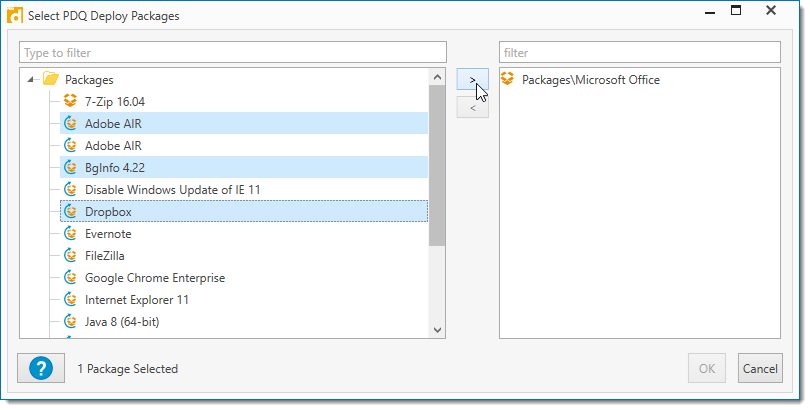 |
4.(Optional) Rearrange the order of the packages by selecting a package, then click the Up or Down arrows.
Attached packages deploy in the order listed, from top to bottom.
NOTE: Packages from the Private Package folder ![]() can only be deployed by the owner of the package unless the package is moved out of the Private Packages folder and made public to other Central Server users.
can only be deployed by the owner of the package unless the package is moved out of the Private Packages folder and made public to other Central Server users.
5.Continue to Part 5: Schedule Deployment Settings.
Part 5: Schedule Deployment Settings
To define deployment settings for the schedule:
1.Click the Options tab.
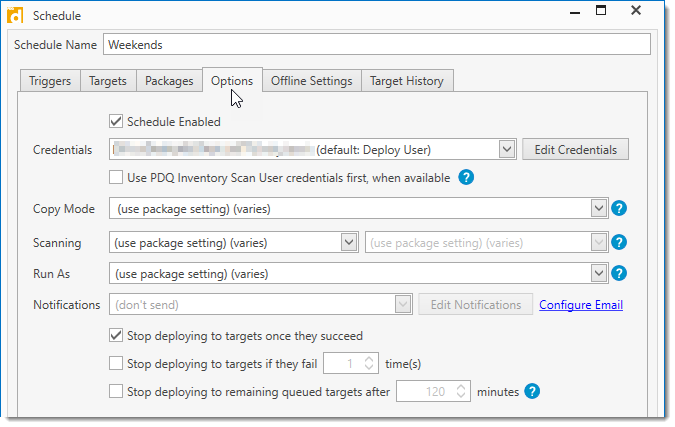
The following table provides information on the Deployment settings available on the Schedule Options tab:
Option |
Details |
|
|---|---|---|
Schedule Enabled |
Enables the Schedule. IMPORTANT: If this option is not selected this Schedule will not run. |
|
The Deploy User credentials used by all deployments in the current schedule. This is the username and password used to connect to the target computer and copy over the necessary files and start the target service. This user must have administrative rights on the target computer, which are needed to copy files to the ADMIN$ share and create and start the remote service. It can be a user account local to the target computer or a domain user if using Active Directory. |
||
Use PDQ Inventory Scan User credentials first, where available |
Allows PDQ Inventory's Scan User credentials to be used during the deployment. If selected, the PDQ Inventory Scan Users credentials will be used first. If no Inventory Scan User credentials exist for that target computer, at the time of the deployment, the selected PDQ Deploy credentials will be used. NOTE: Local Administrator Password Solution (LAPS) can be used by if the target computer's selected Scan User credentials are configured properly to use LAPS. IMPORTANT: Enterprise mode is required in both PDQ Deploy and PDQ Inventory. If running in Client or Server mode, PDQ Inventory must also be in Client or Server mode. |
|
Defines how PDQ Deploy copies deployment files to targets (requires Enterprise mode). You can use the the Package Properties Copy Mode or override it here. When files (such as installation files) are copied to a target, PDQ Deploy can use either Push or Pull Copy Mode. By default, PDQ Deploy uses Push Copy Mode. VIDEO: PDQ Live! Understanding Push and Pull Deployments |
||
|
Push |
Copies files to the targets from the PDQ Deploy computer. This method is best if the package’s install files are located on the PDQ Deploy computer. This option is the default copy mode. Bandwidth throttling applies to all simultaneous file copies combined. |
Pull |
Sends lists of files to the targets which then pull the files from a centralized location. This method works best in WAN environments where the files may be on a file server closer to the targets than the computer where PDQ Deploy is running. For this method to work, all files need to be accessible using a UNC path (e.g. \\server\share\installer.msi). Bandwidth throttling is not enforced when using Pull Copy Mode. WARNING: Files on fixed or mapped drives are not accessible to the target computers; therefore, a valid UNC path must be provided. IMPORTANT: This setting is available only in Enterprise mode. |
|
Select whether or not PDQ Inventory scans target computers after a deployment to identify what is installed on each computer. If your deployment doesn't install an application, you may want to disable inventory scanning for the deployment. IMPORTANT: This feature is available only in Enterprise mode and also requires PDQ Inventory in Enterprise mode. If you are running in Client Mode, PDQ Inventory must be installed on both the Client computer and the Server computer. Additionally, the target computer must already be in PDQ Inventory with a name or hostname that matches the name used in PDQ Deploy. Set the Program Default in Preferences > Deployments or override the default here. |
||
|
Scan after Deployment |
Initiates an inventory scan from PDQ Inventory after the deployment to identify what is installed on each workstation. Scan after Deployment attempts to scan target computers even if deployments fail. This feature can be very helpful in maintaining up-to-date inventory for target machines. The target computers must already be in PDQ Inventory with names or hostnames that match the names used in PDQ Deploy. You may choose which Scan Profile to use. The default Scan Profile is defined in PDQ Inventory in Preferences > Scan Profiles. You can choose to scan with any Scan Profile that has been configured in PDQ Inventory. It is common to use either the Applications or Standard scan profiles. |
Do Not Scan |
Does not scan target computers after deployment. |
|
Determines how all deployments from the current schedule are executed on target computers. IMPORTANT: This feature is available only in Enterprise Mode. For a sample demonstration of the Run As options, see the following video. VIDEO: Deployment Run As Options |
||
|
Use Package Setting |
Uses the Run Package As setting defined at the Package level. If you select this option but the Run Package As setting is not defined at the Package level, then PDQ Deploy uses the global Run Package As setting defined in Preferences. |
Deploy User |
Silently executes deployments on target computers. This setting is appropriate for the vast majority of deployments. |
|
Deploy User (Interactive) |
Executes deployments that include both silent and interactive steps. This setting is the same as Deploy User with one important exception—the Windows process running the deployment is run in interactive mode. This setting is most appropriately used for individual deployments that require user input, but the overall process still requires Administrator rights that logged on users may not have. This type of deployment requires more processing resources. |
|
Local System |
Executes deployments using the Local System account on the target computer. PDQ Deploy connects to the target computer, copies the specified files, then runs the actual deployment service using the Local System credentials. This setting is used only for installations that require Local System. These types of deployments are very rare. |
|
Logged On User |
Attempts to run packages in Interactive mode as the Logged On User of the target machine. This setting is used to deploy applications that are installed per user or when the logged on user needs to provide information for the deployment to succeed such as a license key. It can also be used to modify the HKEY-CURRENT-USER registry hive for the logged on user or to access user-specific settings such as %APPDATA% or the logged on user’s User directory. |
|
Sends an email notification when deployment(s) are finished. (Enterprise mode required.) Choose between Post Deployment Notification (Full Details or Summary), Post Schedule Notification (Full Details or Summary), or create a custom notification by clicking Edit Notifications. The Post Deployment Notification will send an email after each completed deployment whereas the Post Schedule Notification will send one email for the completed schedule and all the included deployment(s). For more information about post deployment emails, see Receiving a Status Email After Deployment and Mail Server Preferences. IMPORTANT: You must configure the Mail Server settings in Preferences as well as designate at least one email recipient in the selected Post Deployment Notification or Post Schedule Notification before you can enable this option. |
||
Stop deploying to targets once they succeed |
Stops deploying to target computers that have already succeeded. NOTE: Success parameters are defined at the Package level. |
|
Stop deploying to targets if they fail xx time(s) |
Stops deploying to target computers once they fail the designated number of times. |
|
Stops deploying and aborts all remaining target computers after the designated number of minutes. Any targets that are running when the timeout elapses will complete their deployment. This option is useful for overnight deployments so queued targets can be stopped before anyone arrives in the office. |
||
2.Click the Offline Settings tab.
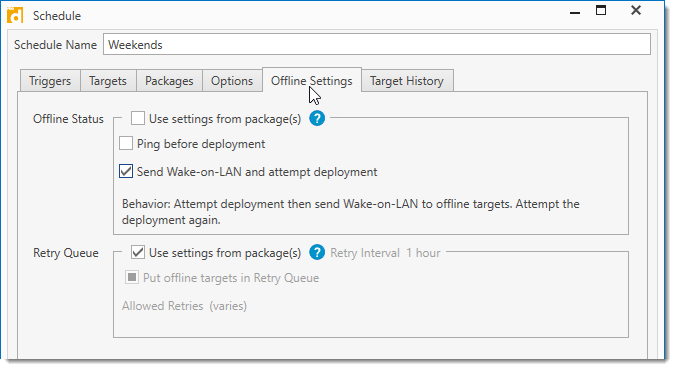 |
The following table provides information on the Deployment settings available on the Schedule Offline Settings tab:
Option |
Details |
|
|---|---|---|
Offline Status settings determines whether computers will receive a ping or Wake-on-LAN prior to deployment. |
||
Use settings from package(s) |
Uses the Offline Status settings defined at the Package level. For more information, see Creating a New Package, Step 1: Package Properties. If you select this option but the Offline Status settings are not defined at the Package level, then PDQ Deploy uses the global Offline Status settings settings defined in Preferences. When you select this option, the subsequent settings are disabled. |
|
Ping before deployment |
Performs a ping (ICMP echo) to all addresses returned by DNS before attempting the deployment on the first to respond. If the target does not respond to the ping within 2 seconds, then the deployment is not attempted on that target. Enabling this option can increase the overall speed of the deployment because PDQ Deploy doesn’t waste time with offline computers. NOTE: Typically, the ping should take only a few milliseconds. However, if your DNS isn’t solid, your network is experiencing latency issues, or your computers have multiple addresses in DNS, then the ping response may take more than 2 seconds. When this is not selected, PDQ Deploy attempts the deployment regardless of the online or offline status of the target computer. If the target is offline or otherwise unavailable, Windows will timeout after ~60 seconds. Leaving this unchecked can decrease the overall speed of the deployment due to these attempts and extra wait time. |
|
Attempts the deployment then sends a Wake-on-LAN to offline target computers. The deployment is attempted again if it comes online. After 5 minutes if the computer is still offline, the deployment will be attempted again. The advantage of this feature is that offline target computers can immediately be made available for deployment. However, it can increase deployment time. IMPORTANT: This feature is available only in Enterprise mode of both PDQ Deploy and PDQ Inventory. Furthermore, PDQ Inventory must have the MAC address of the target computers’ NICs. |
||
Retry Queue settings determine how PDQ Deploy handles deployments when the target computers are offline. |
||
Use settings from package(s) |
Uses the Retry Queue settings defined at the Package level. For more information, see Creating a New Package, Step 1: Package Properties. If you select this option but Retry Queue settings are not defined at the Package level, then PDQ Deploy uses the global Retry Queue settings defined in Preferences. When you select this option, the subsequent Retry Queue settings are disabled. |
|
Put Offline targets in Retry Queue |
Enables the Retry Queue. By default, target computers that are unreachable or offline during a deployment are held in the Retry Queue and deployment is retried. |
|
Allowed Retries |
Sets the number of retry attempts for an offline target computer. This applies per target per deployment. The default setting is 72. To set unlimited retries, set this value to 0. |
|
3.Continue to Part 6: Completing the Schedule.
Part 6: Completing the Schedule
To complete the new schedule:
1.(Optional) Click the Target History tab to view the deployment history of the schedule.
This tab displays a list of target computers, by attached package, that have received deployments using this schedule. Since this is a new schedule, there is no data to display. For more information, see Managing Schedules.
2.When you are finished configuring the schedule, click OK.
The package attached to the schedule deploys according to the settings in your new schedule. Note that if you created a schedule without a package, you need to add one or more packages before the schedule can deploy.
Note: If multiple packages are attached to a schedule, they will deploy in the order listed in the Packages tab, from top to bottom.
3.(Optional) To start the deployment immediately rather than wait for it to run when scheduled, under Schedule Details, click Start Schedule.
The scheduled package(s) deploy immediately.
4.View the progress and the status of the deployment in Deployment Status.
During a deployment you can stop deploying to one or more of the pending target computers by right-clicking on the target(s) and clicking Abort. To retry deployments to computers that fail, right-click the target, and click Redeploy or press Ctrl+R. If a target computer fails, you can view details about the failure, and possible solutions, by clicking the More Info link or the Steps link.
For more information about what happens during and after a deployment, see Verifying Deployment Status.
© 2020 PDQ.com Corporation. All rights reserved.
PDQ.com is a trademark of PDQ.com Corporation. All other product and company names are the property of their respective owners.
Help Version: 19.2.137.0